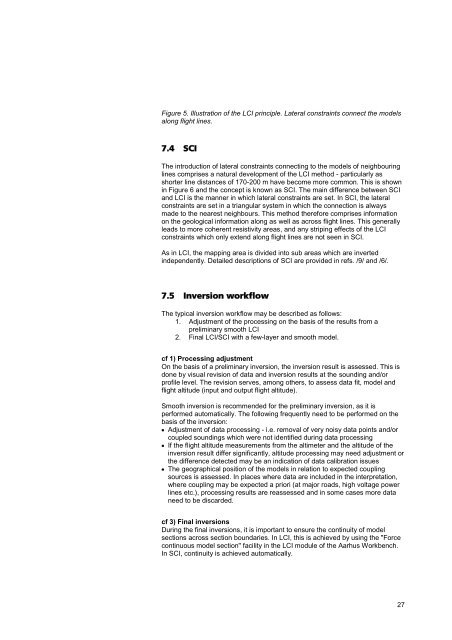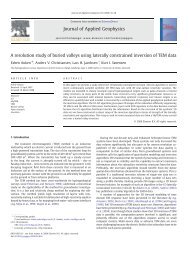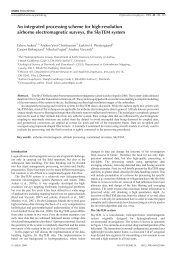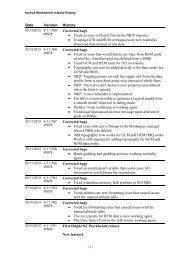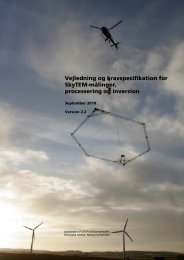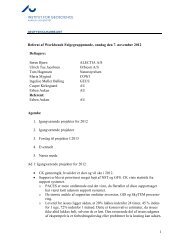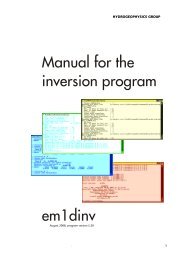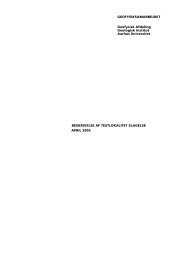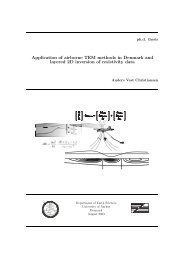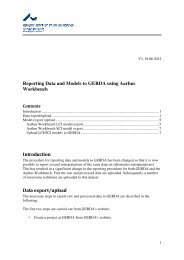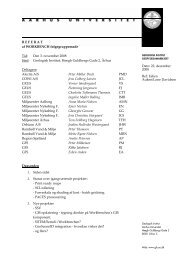guideline and standards for skytem measurements, processing and ...
guideline and standards for skytem measurements, processing and ...
guideline and standards for skytem measurements, processing and ...
Create successful ePaper yourself
Turn your PDF publications into a flip-book with our unique Google optimized e-Paper software.
Figure 5. Illustration of the LCI principle. Lateral constraints connect the models<br />
along flight lines.<br />
7.4 SCI<br />
The introduction of lateral constraints connecting to the models of neighbouring<br />
lines comprises a natural development of the LCI method - particularly as<br />
shorter line distances of 170-200 m have become more common. This is shown<br />
in Figure 6 <strong>and</strong> the concept is known as SCI. The main difference between SCI<br />
<strong>and</strong> LCI is the manner in which lateral constraints are set. In SCI, the lateral<br />
constraints are set in a triangular system in which the connection is always<br />
made to the nearest neighbours. This method there<strong>for</strong>e comprises in<strong>for</strong>mation<br />
on the geological in<strong>for</strong>mation along as well as across flight lines. This generally<br />
leads to more coherent resistivity areas, <strong>and</strong> any striping effects of the LCI<br />
constraints which only extend along flight lines are not seen in SCI.<br />
As in LCI, the mapping area is divided into sub areas which are inverted<br />
independently. Detailed descriptions of SCI are provided in refs. /9/ <strong>and</strong> /6/.<br />
7.5 Inversion workflow<br />
The typical inversion workflow may be described as follows:<br />
1. Adjustment of the <strong>processing</strong> on the basis of the results from a<br />
preliminary smooth LCI<br />
2. Final LCI/SCI with a few-layer <strong>and</strong> smooth model.<br />
cf 1) Processing adjustment<br />
On the basis of a preliminary inversion, the inversion result is assessed. This is<br />
done by visual revision of data <strong>and</strong> inversion results at the sounding <strong>and</strong>/or<br />
profile level. The revision serves, among others, to assess data fit, model <strong>and</strong><br />
flight altitude (input <strong>and</strong> output flight altitude).<br />
Smooth inversion is recommended <strong>for</strong> the preliminary inversion, as it is<br />
per<strong>for</strong>med automatically. The following frequently need to be per<strong>for</strong>med on the<br />
basis of the inversion:<br />
Adjustment of data <strong>processing</strong> - i.e. removal of very noisy data points <strong>and</strong>/or<br />
coupled soundings which were not identified during data <strong>processing</strong><br />
If the flight altitude <strong>measurements</strong> from the altimeter <strong>and</strong> the altitude of the<br />
inversion result differ significantly, altitude <strong>processing</strong> may need adjustment or<br />
the difference detected may be an indication of data calibration issues<br />
The geographical position of the models in relation to expected coupling<br />
sources is assessed. In places where data are included in the interpretation,<br />
where coupling may be expected a priori (at major roads, high voltage power<br />
lines etc.), <strong>processing</strong> results are reassessed <strong>and</strong> in some cases more data<br />
need to be discarded.<br />
cf 3) Final inversions<br />
During the final inversions, it is important to ensure the continuity of model<br />
sections across section boundaries. In LCI, this is achieved by using the "Force<br />
continuous model section" facility in the LCI module of the Aarhus Workbench.<br />
In SCI, continuity is achieved automatically.<br />
27


